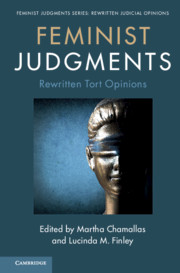Book contents
- feminist judgments: rewritten tort opinions
- Feminist Judgments Series Editors
- Feminist Judgments: Rewritten Tort Opinions
- Copyright page
- Contents
- Notes on Contributors
- Preface
- Table of Cases
- Part I Introduction
- Part II The Classics
- Part III Intentional Torts
- 6 Commentary on Robinson v. Cutchin
- 7 Commentary on Guthrie v. Conroy
- 8 Commentary on Lyman v. Huber
- 9 Commentary on Sipple v. Chronicle Publishing Co.
- Part IV Negligence and Vicarious Liability
- Part V Damages
- Index
6 - Commentary on Robinson v. Cutchin
from Part III - Intentional Torts
Published online by Cambridge University Press: 28 November 2020
- feminist judgments: rewritten tort opinions
- Feminist Judgments Series Editors
- Feminist Judgments: Rewritten Tort Opinions
- Copyright page
- Contents
- Notes on Contributors
- Preface
- Table of Cases
- Part I Introduction
- Part II The Classics
- Part III Intentional Torts
- 6 Commentary on Robinson v. Cutchin
- 7 Commentary on Guthrie v. Conroy
- 8 Commentary on Lyman v. Huber
- 9 Commentary on Sipple v. Chronicle Publishing Co.
- Part IV Negligence and Vicarious Liability
- Part V Damages
- Index
Summary
Robinson v. Cutchin involved the nonconsensual sterilization of an African-American woman because the doctor thought that she had enough children. Although unconsented to medical treatment presents a traditional tort claim for battery, the trial judge dismissed this claim because he considered the sterilization neither physically harmful nor offensive. The rewritten feminist opinion draws on the history of involuntary sterilization of women of color to conclude that such conduct is inherently outrageous and causes serious physical and emotional harm, and thus should be redressed as both a battery and as intentional infliction of emotional distress, with punitive damages. The feminist opinion highlights the ways the actual judgment distorts both the law and the reality of women’s experience of harm. The accompanying commentary situates this case in the history of racially based involuntary sterilization and both medical and judicial dismissiveness of the seriousness of the harm, and thus sheds light on how tort law has failed to deter this abusive practice.
Keywords
- Type
- Chapter
- Information
- Feminist Judgments: Rewritten Tort Opinions , pp. 121 - 146Publisher: Cambridge University PressPrint publication year: 2020

